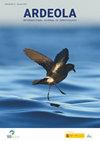Long-Term Decoupling of a Local Population Trend of the European Pied Flycatcher Ficedula hypoleuca from Nest Box Abundance Indicates the Importance of Old-Growth Forest
IF 1.2
4区 生物学
Q2 ORNITHOLOGY
引用次数: 0
Abstract
Summary. Most populations of the European Pied Flycatcher Ficedula hypoleuca are decreasing. Different reasons for the decline are discussed, including biotic interactions and climate change. It is evident that many studies have been conducted in populations depending completely on nest boxes, but the influence of this artificial support on population dynamics is not well understood. We investigated the population dynamics of the Pied Flycatcher in the Kottenforst, an old-growth forest in western Germany, using recent data as well as historical records. We also determined the proportion of pairs breeding in nest boxes vs. natural nesting places. Specifically, we quantitatively analysed forest structure around tree holes occupied by the Pied Flycatcher. We found a continuous increase in population size since its establishment in the 1960s, which contrasts with overall long-term population trends in Europe as well as the regional trend. Whereas importance of nest boxes decreased over recent years, the majority of pairs are occupying tree holes for breeding, which are abundant in the richly structured, open old-growth forest. This forest structure seems to be optimal for the Pied Flycatcher since it allows flying insects to be hunted close to the nest. Finally, we discuss how forest structure and age as well as tree hole and insect availability may determine population trends of the Pied Flycatcher and highlight the importance of long-term studies. —Abrahamczyk, S., Grimm, J., Fehn, M. & Stiels, D. (2023). Long-term decoupling of a local population trend of the European Pied Flycatcher Ficedula hypoleuca from nest box abundance indicates the importance of old-growth forest. Ardeola, 70: 185-200. Resumen. La mayoría de las poblaciones de papamoscas cerrojillo Ficedula hypoleuca están disminuyendo. Se discuten diferentes razones de este declive, entre ellas las interacciones bióticas y el cambio climático. Es evidente que se han realizado muchos estudios en poblaciones que dependen completamente de las cajas nido, pero no se conoce bien la influencia de este soporte artificial en la dinámica poblacional. Hemos investigado la dinámica poblacional del papamoscas cerrojillo en Kottenforst, un bosque antiguo del oeste de Alemania, utilizando datos recientes y registros históricos. También determinamos la proporción de parejas que crían en cajas nido frente a lugares de nidificación naturales. En concreto, analizamos cuantitativamente la estructura forestal en torno a los huecos de los árboles ocupados por el papamoscas cerrojillo. Encontramos un aumento continuo del tamaño de la población desde su establecimiento en la década de 1960, lo que contrasta con las tendencias poblacionales generales a largo plazo en Europa, así como con la tendencia regional. Mientras que la importancia de las cajas nido ha disminuido en los últimos años, la mayoría de las parejas ocupan agujeros en los árboles para criar, que son abundantes en el bosque antiguo, abierto y ricamente estructurado. Esta estructura forestal parece ser óptima para el papamoscas cerrojillo, ya que permite cazar insectos voladores cerca del nido. Por último, discutimos cómo la estructura y la edad del bosque, así como la disponibilidad de huecos en los árboles y de insectos, pueden determinar las tendencias poblacionales del papamoscas cerrojillo y destacamos la importancia de los estudios a largo plazo.—Abrahamczyk, S., Grimm, J., Fehn, M. y Stiels, D. (2023). La desvinculación a largo plazo entre la tendencia poblacional local del papamoscas cerrojillo Ficedula hypoleuca y la cantidad de cajas nido indica la importancia del bosque maduro. Ardeola, 70: 185-200.欧洲斑姬鹟种群趋势与巢箱丰度的长期解耦表明原生林的重要性
总结。欧洲斑蝇的大部分种群数量都在减少。讨论了不同的原因,包括生物相互作用和气候变化。显然,许多研究已经在完全依赖巢箱的种群中进行,但这种人工支持对种群动态的影响尚未得到很好的理解。我们利用最近的数据和历史记录调查了德国西部kottenforest(一个古老的森林)中斑蝇的种群动态。我们还确定了在巢箱中与自然筑巢地繁殖的配对比例。具体来说,我们定量分析了斑蝇占据的树洞周围的森林结构。我们发现,自1960年代成立以来,人口规模持续增长,这与欧洲的整体长期人口趋势以及区域趋势形成鲜明对比。虽然巢箱的重要性近年来有所下降,但大多数对都占据树洞进行繁殖,这在结构丰富,开放的原始森林中是丰富的。这种森林结构似乎对斑衣捕蝇器来说是最理想的,因为它允许在巢附近捕猎飞虫。最后,我们讨论了森林结构和年龄以及树洞和昆虫可利用性如何决定斑蝇的种群趋势,并强调了长期研究的重要性。——abrahammczyk, S., Grimm, J., Fehn, M. & Stiels, D.(2023)。欧洲斑姬鹟的种群趋势与巢箱丰度的长期分离表明了原生林的重要性。中国生物医学工程学报,21(3):391 - 391。Resumen。La mayoría de las poblaciones de papamoscas cerrojillo Ficedula hyppoleuca están disminuyedo。他们讨论了不同的razones de este declive, entre ellas las interacciones bióticas y el cambio climático。显而易见的是,我们需要意识到,许多工作室的工作都依赖于他们的工作能力,他们的工作能力取决于他们的工作能力,他们的工作能力取决于他们的影响,他们的工作能力取决于他们的工作能力。Hemos investigado la dinámica poblacional del papamoscas cerrojillo en Kottenforst, unbosque antiguo del oeste de Alemania, utilizanddo datos registros históricos。tamambien - determinas as proporción de parejas que crían en cajas nido frente de lugares de nidificación naturales。具体地说,是对森林结构的定量分析和对森林结构的定量分析,对森林结构的定量分析和对森林结构的定量分析。继续追查追查追查tamaño追查追查población追查追查1960年的追查追查,追查追查一般问题的趋势,追查欧罗巴大广场,así追查追查区域趋势。Mientras que la importancia de las cajas nido has disminuido en los últimos años, la mayoría de las parejas ocupan agujeros en los árboles para criar, que son antes en el bosque antiguo, abierente structurado。Esta结构的森林资源服务óptima para el papamoscas cerrojillo,你问许可的森林昆虫voladores cerca del nido。穷último, discutimos cómo la structura la edad del bosque, así como la disponbilidad de huecos en los árboles y de incotos, pueden determinar las tendencias posblacionales del papamoscas cerrojillo y destacamos la importancia de los estustos a large plaza。——abrahammczyk, S., Grimm, J., Fehn, M. y Stiels, D.(2023)。La desvinculación a大广场中心,La倾倾性的地方,del papamoscas, cerrojillo, Ficedula, hypolucas, La cantidad, cajas nido, indica,重要的是,del bosque maduro。中国生物医学工程学报,21(3):391 - 391。
本文章由计算机程序翻译,如有差异,请以英文原文为准。
求助全文
约1分钟内获得全文
求助全文
来源期刊
CiteScore
2.30
自引率
6.20%
发文量
16
审稿时长
>12 weeks
期刊介绍:
Ardeola: International Journal of Ornithology is the scientific journal of SEO/BirdLife, the Spanish Ornithological Society. The journal had a regional focus when it was first published, in 1954. Since then, and particular during the past two decades, the journal has expanded its thematic and geographical scope. It is now a fully international forum for research on all aspects of ornithology. We thus welcome studies within the fields of basic biology, ecology, behaviour, conservation and biogeography, especially those arising from hypothesis-based research. Although we have a long publication history of Mediterranean and Neotropical studies, we accept papers on investigations worldwide.
Each volume of Ardeola has two parts, published annually in January and July. The main body of each issue comprises full-length original articles (Papersand Review articles) and shorter notes on methodology or stimulating findings (Short Communications). The publication language is English, with summaries, figure legends and table captions also in Spanish. Ardeolaalso publishes critical Book Reviewsand PhD-Dissertation Summaries; summarising ornithological theses defended in Spain. Finally there are two Spanish-language sections, Ornithological News; summarising significant recent observations of birds in Spain, and Observations of Rare Birds in Spain, the annual reports of the Spanish Rarities Committee.

 求助内容:
求助内容: 应助结果提醒方式:
应助结果提醒方式:


